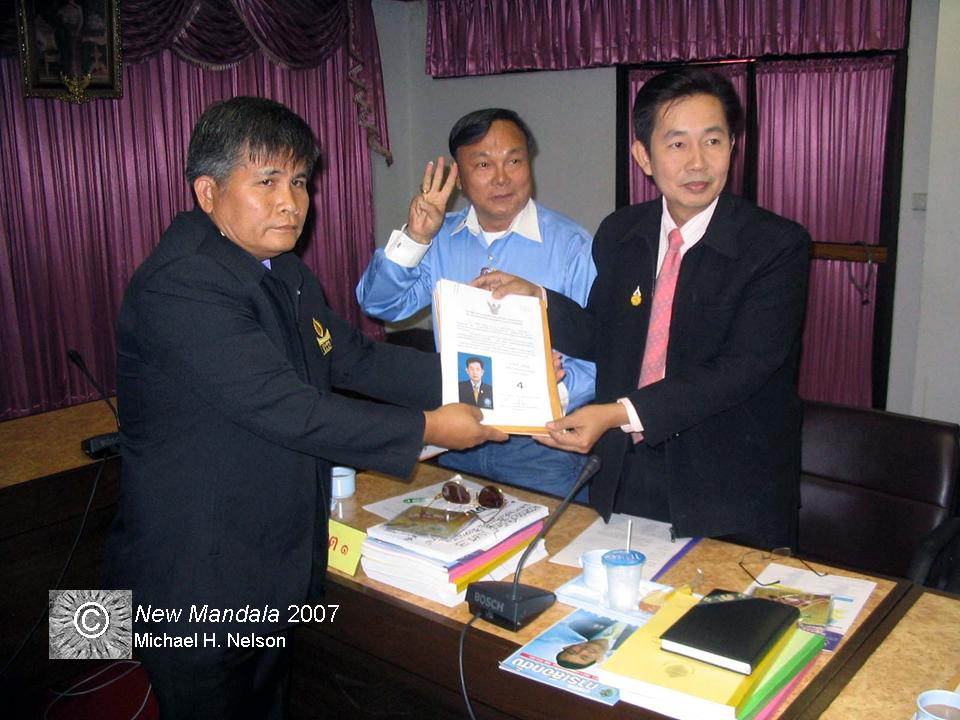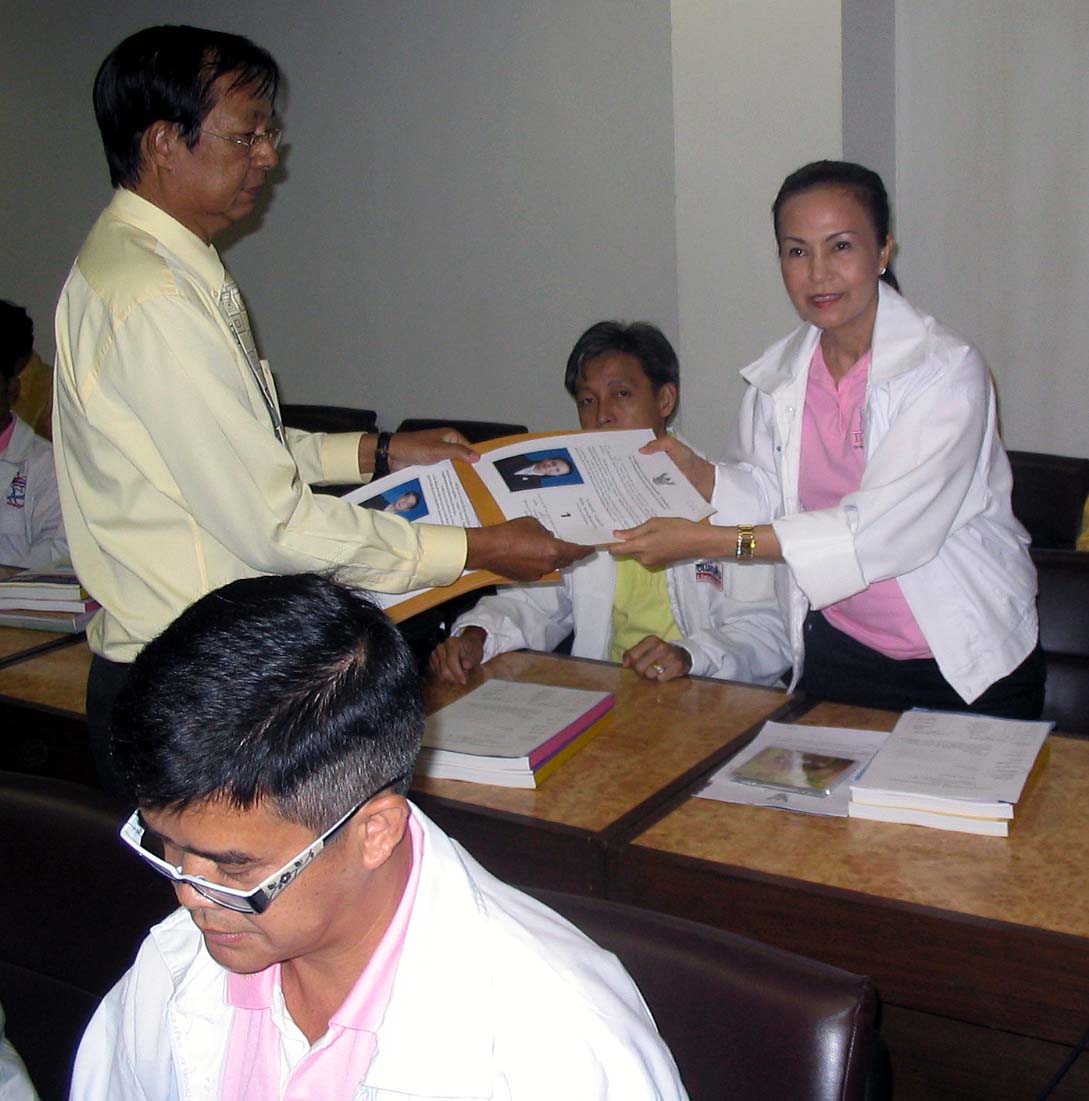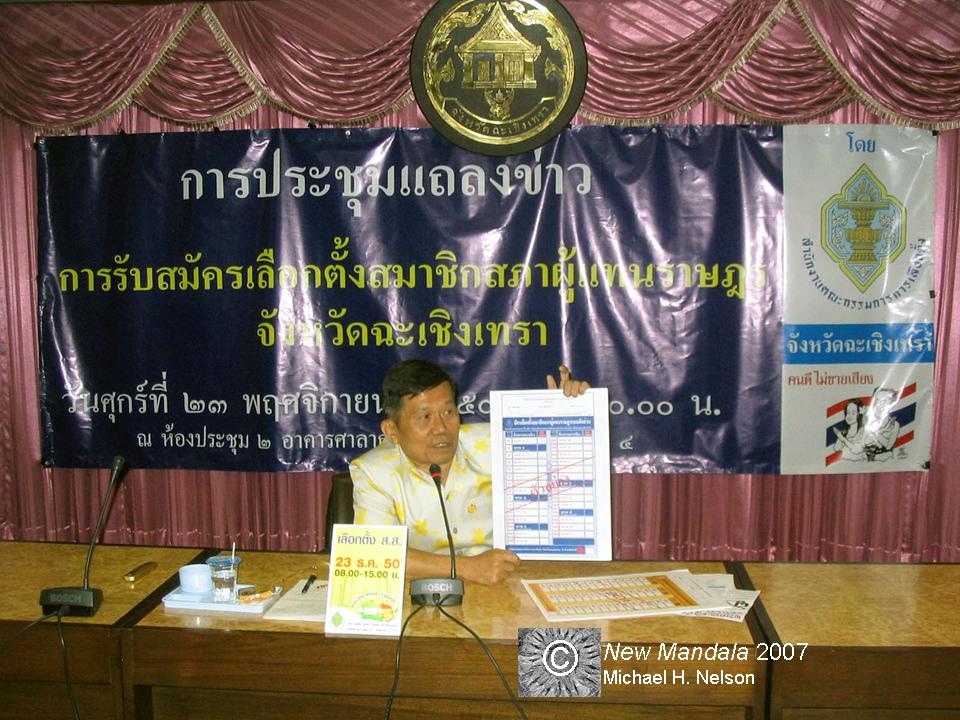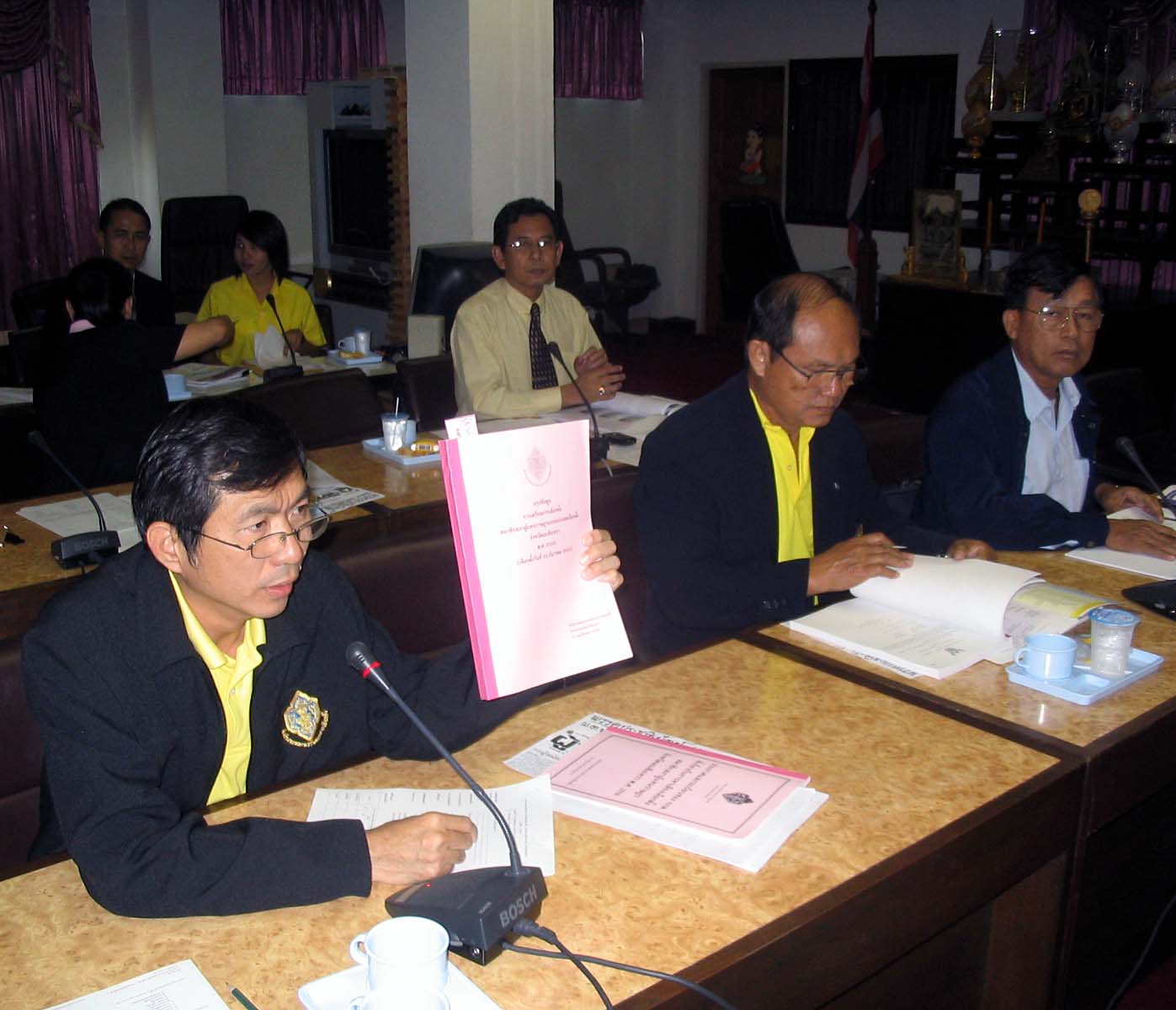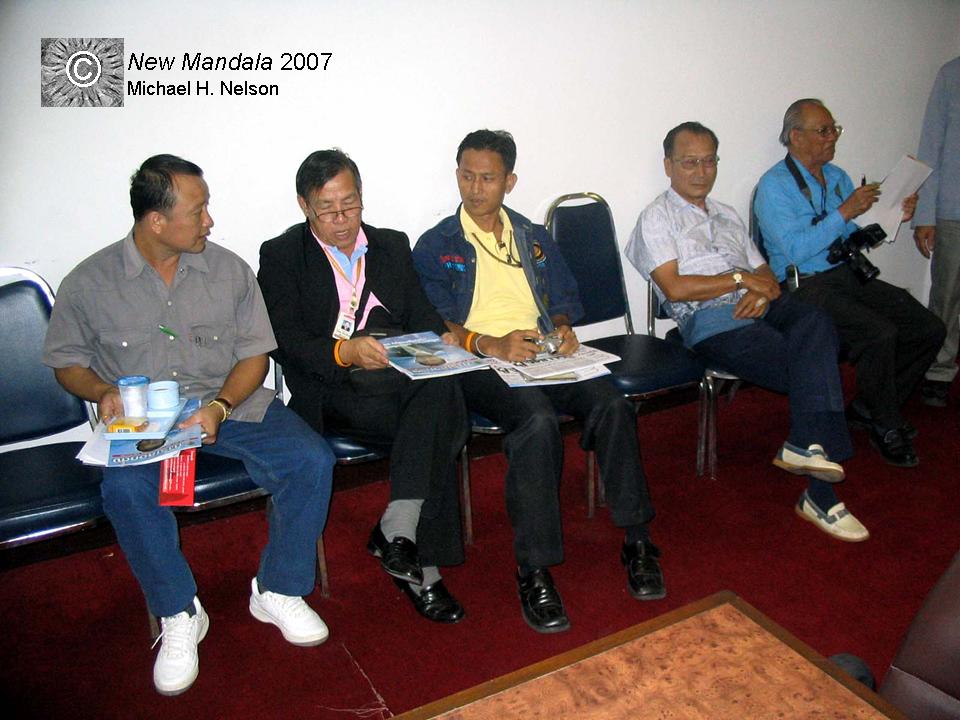On November 23, 2007, most MP candidates attended a meeting called by the provincial election commission (PEC) of Chachoengsao province to distribute the forms concerning the official acknowledgement of their candidacies. In addition, the candidates were informed of a number of issues, and they received a huge stack of documents. At the oath-taking ceremony a week earlier, Thitima and Wuthipong Chaisaeng of the People’s Power party (PPP) were very late and visibly unenthusiastic. This time, they did not show up at all. This was in marked contrast to the run-up to the elections of 2005, when they ran under the Thai Rak Thai banner riding high on the wave of Thaksin Shinawatra’s popularity. At that time, they were sure to regain their MP seats and attended the equivalent meeting in a relaxed and confident mood. On our way to have lunch, I asked an election commissioner about this absence of two main competitors. “It is all about spirit,” he said, adding, “you saw how it was at the oath-taking ceremony.”
In fact, the candidacy confirmation was not the task of the PEC or its office, but of the two constituency committees. Picture 1 shows the director of constituency 1, Ajarn Sawat Robru, handing over the form to Chalee Charoensuk, who runs as No. 4 for the Democrat party. Behind him stands his running mate, No. 3, Phatcharakriengchai Singhanat. Holding up his three fingers probably shows that he could not resist to use this official act to try and campaign for himself. Both candidates should stand little chance of beating their two competitors of the PPP, Khun Itthi and Khun Somchai (“sia nao“).
Picture 1
Picture 2 shows the director of constituency 2, Ajarn Sombat Anari, giving the document to Phanee Jarusombat, who had won the Senate race by a large margin and is strongly tipped to make it to the House. Both constituency directors are also directors of secondary schools. This has the advantage that the ECT can make use of educational facilities and personnel for administering the election.
Picture 2
Altogether, there are 20 candidates running under 10 party labels in constituency 1, and 16 candidates running under eight party labels in constituency 2 (two parties run only in constituency 1). This is a significant increase over 2001 and 2005, when in the then four single member constituencies combined only 22 (four parties) and 11 candidates (three parties), respectively, entered the races. The preceding two multi-member constituencies in the elections of 1992 (March and September) , 1995, and 1996 had, on an average, eight candidates in both of the two constituencies (four parties). Despite the high number of candidates, only three of them in each constituency are given good chances to win a seat. In constituency 1, these are Itthi and Somchai of PPP and Pichet Tancharoen of Phuea Phaendin. In constituency 2, Phanee of Phuae Phaendin is seen as the most promising candidate, with one seat probably going to PPP, either Thitima or Wuthipong. A local stringer working for a number of newspapers recently had an article in Siam Rath in which he suggested that many hua khanaen had been moving from the Chaisaengs to Phanee. The everyday explanation for such a thing is that they are better paid by the latter. However, the multi-member constituency arrangement allows hua khanaen to canvass votes both for Phanee and one of the Chaisangs. In this constituency, the Democrat candidates might stand a small chance. In other words, the great majority of candidates joins the race, for whatever reasons, being fully aware that they will never make it.
As for the assumption that multi-member constituencies weaken political parties, because members are forced to compete against each other, one might have some doubts. First, there are basically no political party structures in Chachoengsao, and very few in Thailand in general (the Democrats are an exception only to a certain degree; see Marc Askew on Culture and Electoral Politics in Southern Thailand). Thus, they cannot get much weaker. The candidates, including those of the Democrats who do not run in Bangkok but in up-country constituencies, thus do not normally grow out of party structures and their political discourses at the provincial or national levels. Rather, the candidates are individuals who recruit themselves to the parties or are recruited by them based on the strength of their personal voter bases (than siang).
Supra-provincial political factions that assemble a number of provincial-level politicians under a more or less strong leader are also important because they temporarily align themselves with political parties for electoral and governmental purposes. Probably the best-known example is Sanoh Thienthong’s Wang Nam Yen faction. He so effectively moved his faction of provincial MPs from party to party that he was able to play a decisive part in making the prime ministers Banharn (Chart Thai party), Chavalit (New Aspiration party), and Thaksin (Thai Rak Thai party). Note that these are three different political parties, but one faction, though with partly changing membership. Moreover, Chart Thai is a small party with its core in Suphanburi province, while both New Aspiration and Thai Rak Thai do not exist any longer. However, Sanoh has also passed his prime, being left with merely a handful of MP-hopefuls, and no opportunity to play the kingmaker again. Another important faction leader, Somsak Thepsuthin, formerly with TRT, seem to have played his cards wrongly. At the beginning of the party and faction realignments, after TRT had been dissolved, he proudly declared that his faction will be one of the biggest after the election. Now, the faction’s party incarnation as Matchimathipattai, under failed Chinese tycoon and “political kindergarten student” (Sanoh) Prachai Leopairatana, is internally fractured and tipped to receive merely 23 seats.
In most cases, MP candidates are members or even leaders of more or less developed informal political groups (phuak) operating at the provincial and local levels. Often, family (trakun) interests are very important, such as in the case of the Chaisaeng and Tancharoen clans in different parts of Chachoengsao, the “good” strongman Banharn Silpa-archa in Suphanburi (Nishizaki has described this “fussy strongman” in a series of articles), the “bad” archetypical godfather or chao pho Kamnan Po in Chonburi (now in hiding and replaced by his well- and partly US-educated three sons), the Chidchobs in Buriram, and the Tiyapairats in Chiang Rai (for a brief general outline see my “Analyzing Provincial Political Structures in Thailand: phuak, trakun, and hua khanaen“).
Second, political competition in established party systems is not absent since candidates go through competitive selection processes within their parties. However, this does not seem to weaken the parties, but is seen positively as intra-party democracy. Third, the competitive situation of party candidates in Chachoengsao varies greatly. The running mates of Phichet and Phanee of Phua Phaendin are only seen as filling in the second party slots, not as serious competitors. Most campaign posters and introductory campaign cards of Phichet do not even mention his running mate. Itthi and Somchai of PPP are not competitors at all, because they have been acting as a political couple for many years. Thus, they aim at jointly maximizing their election result. This is reinforced by the long-standing feud between them and Phichet’s brother, Suchart Tancharoen, who was disqualified for having been a member of TRT’s executive board. That Suchart’s replacement, his brother Phichet, is reported to have made inroads with the hua khanaen will only strengthen Itthi’s and Somchai’s determination.
By the way, the other day, my landlord spoke very positively of Itthi. He was capable and knowledgeable. He had successfully studied at the faculty of political science of Chulalongkorn University when very few people in Chachoengsao would dream of doing so. In fact, my landlord said, Itthi did not want to “play politics.” Many years ago, he had asked him, because he thought that having a degree in political science well qualified him for entering provincial politics. At that time, Itthi had only laughed for an answer. However, his father was a big-time trader in Phanom Sarakham district, and thus had a huge network of connections. In addition, he had always helped people in need, thus creating a substantial baramee. So, he had pushed his son into politics. “When he started his political work,” my landlord said, “Itthi had to rely on the baramee of his father. But not any longer since, over the years, he has built up his own achievements.” When I stood with Itthi on the stage of an electioneering event organized by the constituency committee, he held my hand for some time and recalled his career. He emphasized the necessity of continuous work to built ones political basis in a certain geographical area. At the end, he turned his head close to me and said in English, “Rome was not built in one day.” This story of political recruitment in Thailand sounds very familiar. And it is not surprising that political parties did not figure in either talk. Itthi comes across as a very alert and professional politician with a systematic approach to his political work.
Thitima and Wuthipong Chaisaeng’s competition is more intra-family than intra-party. The Democrat candidates in constituency 2 might have a competitive situation, because they think that one of them might be able to gain the second seat left over by Phanee. However, within the constituency, they have different groups of supporters, and little time is left until the election to competitively work the big constituency. The candidates standing for the Democrats in constituency 2 should have little pressure to fight each other toe-to-toe because few observers and even they themselves do not seriously expect to gain a seat. This situation is even more true of the candidates of all the other political parties.
We should not forget the proportional vote. Chachoengsao belongs to group 5, comprising ten provinces. Besides Chachoengsao, these are Chanthaburi, Chonburi, Trat, Nakorn Nayok, Nakorn Ratchasima, Pathum Thani, Prachinburi, Rayong, and Sakaew. In this cluster, 16 political parties have submitted party lists.
Returning to the meeting, it was presided over by the chairman of the PEC. Picture 3 shows him explaining the party list ballot paper to the candidates. In picture 4, the director of the PEC office makes a point about the “Summary data about the MP election in Chachoengsao province”, which was prepared by his staff (some of them are seen in the background) and distributed to all candidates. To his right are two members of the ECT. Some members of the local press also observed the meeting (picture 5).
Picture 3
Picture 4
Picture 5
PEC member Ajarn Prawat (on the right in picture 4), in a brief speech, told the candidates that he was worried about illegal electioneering methods. They could not place stacks of leaflets with their pictures in restaurants, neither could they put up posters. He cautioned (or perhaps threatened) the candidates that, from his 30 years as lecturer at the Teacher’s College in Chachoengsao, he had a great number of former students who would provide him with information. In fact, he had already received many phone calls about doubtful electioneering methods. It was not that he did not know of illegal practices, but he still lacked evidence. Candidates must not use local governments in their campaigns, and neither can they provide free food for voters at restaurants. If no candidate distributed money, then things would be fine. They should do it for the King who all of them extraordinarily loved. Finally, he did not want the candidates to destroy the institution of sub-district and village headmen by using them as hua khanaen, because they were necessary for the security of the nation.
Democrat candidate Phatcharakriengchai, in his usual aggressive style, added that money had already been distributed at the rate of 500 baht per head. It was as if hima tok (it had “snowed”). Competitors had already called meetings with local government politicians and sub-district and village headmen. He wanted that evil (khwamchua) to disappear from Chachoengsao. This was a rather direct attack on Itthi and Somchai in front of most other candidates, the PEC, and the constituency committees. Phatcharakriengchai later made some more scathing remarks while on the stage of an electioneering event organized by the constituency committee responsible for constituency 2. This had led to its director cautioning him that, if he continued talking this way, he will not any longer be allowed to speak at such events. Moreover, Itthi has been considering legal action because he felt that the Democrats’ candidate had libeled him.
The ECT, and thus the PECs, have implemented an anti-vote buying drive. Picture 6 shows an ECT-issued poster about fraudulent election practices. In the box below, it is stressed that information provided will be kept secret. Indeed, rumors of vote-buying have always been rife, without the ECT or anybody else being able to produce any evidence. An election official once told me, “Michael, how can the police help us in tracking down vote buyers when they themselves are amongst them?” The standard sentence is this context is, “mai mi lakthan” (there is no evidence). Moreover, people do not normally dare to come forward because this will make their lives in their village not any easier. Election candidate Boonlert Pairin, a former senator, rightly remarked at the above meeting that evidence in a court sense was not necessary to disqualify candidates or to order new elections. Both the previous and the current constitution merely require that a certain amount of plausibility concerning the wrongdoing exists.
Picture 6
Picture 7 shows the back of the director of constituency 1 wearing a polo shirt with the official symbol of the anti-vote buying drive. The text reads, “We Thais are united in not selling our votes.” The line below reads, “Vote buying and selling violate the law and hurt the nation.”
Picture 7
Since the ECT has stressed the fight against vote buying so much, it is under pressure to produce results in terms of disqualifying candidates and ordering new elections after the original election on December 23 has been completed. Otherwise, it will look as if the ECT can merely talk, but not act; it will appear as a paper tiger (suea kradat), and its competence in managing elections will come into more doubt.
 Facebook
Facebook  Twitter
Twitter  Soundcloud
Soundcloud  Youtube
Youtube  Rss
Rss 